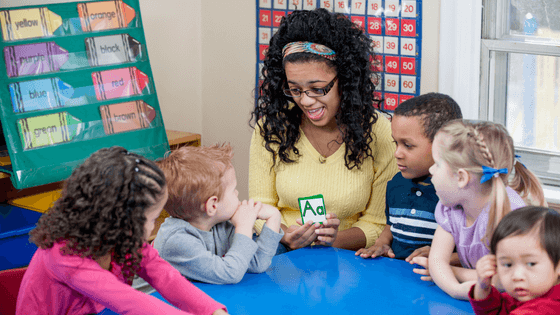Helping students improve their ESL pronunciation and phonics is an essential part of any English language teacher’s job. Yet, particularly for new teachers, it’s not always obvious how to incorporate pronunciation practice and assessment (let alone the phonemic chart!) into lessons. To help, we’ll explore the ways pronunciation and phonics lead to effective communication and share some English pronunciation tips you can use in your classroom or when teaching English online.
Taking a Micro-credential course in Teaching English Pronunciation can help you learn the mechanisms and methods behind effective pronunciation practice. If you’re new to teaching, you’ll want to get initial training and qualification with a TEFL certificate. You can explore our online TEFL courses to get started!
- Why is it important to teach ESL pronunciation and phonics to students?
- I’m lost in terminology! What do the different pronunciation-related terms mean?
- How do you teach pronunciation to students in the English classroom?
- How do you practice pronunciation in ESL?
- How do you assess your ESL students’ pronunciation?
Why is it important to teach ESL pronunciation and phonics to students?
Effective communication
No matter what level your students are, no matter how advanced or fluent they are, if their pronunciation of certain key sounds is incorrect, they’ll be misunderstood by other speakers of English. For example, if an English learner talks about owning three ship (/ʃɪp/), but actually means three sheep (/ʃi:p/), the listener might assume that he or she is a very rich person, while the speaker in fact just wants to talk about his private little farm.
In such a case, the purpose of learning English to effectively communicate with other people around the world is not fulfilled. This can be extremely demotivating for learners of a language, and it can also cause students to hesitate to speak.
The same goes, of course, for students’ listening skills. If your English students misunderstand the word ship (/ʃɪp/) as sheep (/ʃi:p/) when they hear it, similar confusion will arise.
For effective communication, both receptive and productive skills are equally important. This is why it’s essential to equip your students with the necessary tools to speak and listen, right from the beginning of their lessons.

Differences in phonemic script
If you’re teaching students whose first language does not use the same alphabet as English, such as Japanese, Chinese, Korean, or Arab students, they will have an extra obstacle to overcome as they learn English. Your students are not just learning new words and grammar but also a new alphabet and the sounds that each letter makes. For these students, adding some phonics lessons to your curriculum can be a great help. Phonics refers to the sound system of a language and includes how sounds are pronounced, how syllables or words are stressed, and intonation.
All of these advantages will boost your students’ confidence and motivation to keep learning!

I’m lost in terminology! What do the different pronunciation-related terms mean?
We’ve touched on the concept of phonics, but the terminology surrounding ESL pronunciation can be confusing at times, especially if you’re a native English-speaking teacher and you’re expected to teach the rules and patterns of your mother tongue that just come naturally to you.
To start, you can review the basic features of pronunciation with the following infographic, from the Bridge Micro-credential course in Teaching English Pronunciation:
Next, let’s review a list of the most important vocabulary and buzzwords you will need to prepare for your ESL pronunciation lessons.
Teach your students to speak with confidence with the
Micro-credential in Teaching English Pronunciation
Get CertifiedHow do you teach pronunciation to students in the English classroom?
When it comes to how to teach pronunciation to ESL students, it’s important to consider phonics. Teaching phonics can be daunting, but with the right tricks and pronunciation activities, your students’ ESL pronunciation practice can be smooth, and even fun! The basic goal is to help your students connect letters and letter compounds with sounds to produce audible language. So, how can you approach a phonics lesson?
The phonemic chart
A basic tool in the ESL classroom is the phonemic chart. Referring to the chart on a regular basis can help your students get familiar with new words quickly, and they can sound out new words by themselves by looking at the chart. Keep a poster-sized chart in your classroom (or in the background of your screen if you’re teaching online) so your students have easy access to it!
If you need more help understanding the IPA chart, check out the following clip from a recent BridgeUniverse Expert Series webinar, Teaching English Pronunciation: Understanding and Utilizing the IPA Chart. You can watch the full webinar here.
Tongue positions and mouth movement
Using pictures of the position of the tongue and the movement of the mouth for each phoneme will help your students understand the physical aspect of language production. By giving a live example yourself and going through the movements with your students, they might feel more comfortable copying you, rather than trying only by themselves.
If you’re teaching English online, you can also demonstrate the sound, but be careful about the angle and zoom of your camera. You don’t want to scare off your students by showing them a close-up of the inside of your mouth! While this might work for younger students by making them laugh, adult students may feel uncomfortable. In many cases, referring to a picture can be enough.
Word stress, sentence stress, and intonation
English is a stress-timed language, so it is very important to put the stress in the right place in a word and on the right words in a sentence in order to convey the intended message. (An ESL student whose language is syllable-timed rather than stress-timed needs a lot of ESL pronunciation practice to stress English sounds correctly.)
This focus on stress goes for both productive speaking skills as well as for receptive listening skills. Including intonation and stress practice in your lessons right from the beginning is very important in order to prepare your students to deal with English as it is regularly used by other speakers of English.
How do you practice pronunciation in ESL?
Incorporating ESL pronunciation games and fun speaking activities is a great way to get students to loosen up while enhancing their skills. Here are some pronunciation activities teachers can use:
- Minimal pairs: There are plenty of ways you can incorporate minimal pairs into games. You can use them to play Bingo or print out minimal pairs flashcards that you place on a table and have students race to grab the correct one you call out.
- Songs: Using sing-alongs is a fun way to get students to practice and perfect their English pronunciation.
- Tongues twisters: These are great for targeting specific English sounds.
- Video/audio resources: Have students listen to a famous speech or watch a TED Talk. Then, they can create their own scripts to imitate what they’ve heard. Exposure to people who speak clearly is one of the best ways to improve students’ pronunciation.
- Pronunciation apps: Tools like ELSA Speak and Sensay can be great resources when assigning homework and getting students to practice their pronunciation outside of class.
Here are more ideas, from a BridgeUniverse Expert Series webinar, for using ESL pronunciation games in your classroom:
How do you assess your ESL students’ pronunciation?
Assessment and feedback play an important role in any ESL classroom. If you are teaching ESL pronunciation, you will need to assess your students’ progress at some point, too. Here are some ideas on how to assess and give feedback to your ESL students.
Monitoring
During a group speaking activity, walk around the room and listen, taking notes on your students’ pronunciation errors. Later, you can organize your notes and give individual error correction feedback (in written form or during a personal meeting) or create a lesson for the whole class based on common errors you observed.
Student presentations
Have your students do individual or group presentations in front of the class. Ask the rest of the class to take notes, fill out a rubric sheet, or write a comment on each presentation, focusing on pronunciation and intonation. After each presentation, students can give each other feedback. This works well if the students are comfortable with each other and are motivated to participate in class. You can also add your own comments afterward.
Audio/video recording
If you’re teaching English online, having your students hand in audio or video recordings is a convenient way to assess their ESL pronunciation. Some ways you can do this are:
Regardless of the activity, you can play their recordings over and over in order to write extensive feedback.

Interview
If you’re teaching English for Specific Purposes, creating an interview test that includes the target language and is set in a specific context is a good way to assess more advanced students. During the interview, you can repeat the incorrectly pronounced words back to your student and give them a chance to self-correct.
Graded paper test
If you are working in a public or private school, you might be asked to do some grading based on paper tests, or similar easy-to-process assessments. In that case, you can create tests on minimal pairs, word stress, sentence stress, and intonation, and if possible, include a listening section with your own voice recordings.
Teaching ESL pronunciation is a challenging part of English language teaching. However, including ESL phonics practice in your lessons and helping your students produce intelligible language will improve their ability to communicate effectively with people around the world and help to fulfill the purpose of learning English.














